Texas Residential Lease Agreement
This Texas Residential Lease Agreement ("Agreement") is made and entered into this ___ day of __________, 20___, by and between:
Landlord: _______________________________________ (Name)
Address: _______________________________________
Phone Number: _________________________________
and
Tenant: _______________________________________ (Name)
Address: _______________________________________
Phone Number: _________________________________
1. Property Description: The Landlord agrees to lease to the Tenant the residential property located at:
_______________________________________________________ (Address of the rental property).
2. Lease Term: This Agreement will begin on __________, 20___, and will end on __________, 20___ (the "Lease Term").
3. Rent: The Tenant agrees to pay the Landlord a monthly rent of $____________, payable in advance on the _____ day of each month.
4. Security Deposit: The Tenant shall pay a security deposit of $____________, due at signing this Agreement. This deposit will be returned within 30 days after the Lease Term ends, subject to any deductions for damages beyond normal wear and tear.
5. Utilities: The Tenant is responsible for the payment of the following utilities:
- Electricity
- Water
- Gas
- Internet/Cable
6. Use of Property: The property shall be used exclusively as a personal residence. No other use is allowed without the written consent of the Landlord.
7. Pets: [ ] Pets are allowed [ ] Pets are not allowed. If allowed, any additional rules or deposits may apply.
8. Maintenance and Repairs: The Tenant agrees to keep the property clean and in good condition. Any needed repairs should be reported to the Landlord promptly.
9. Termination: Either party may terminate this Agreement at the end of the Lease Term by providing written notice ___ days prior to the end date.
10. Governing Law: This Agreement shall be governed by the laws of the State of Texas.
IN WITNESS WHEREOF, the parties have executed this Lease Agreement as of the date first above written.
Landlord Signature: ________________________________
Date: ___________________________________________
Tenant Signature: ________________________________
Date: ___________________________________________
